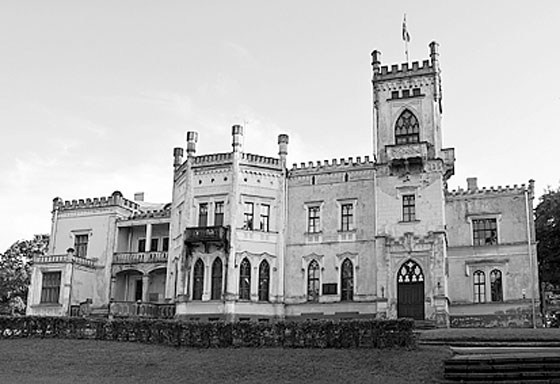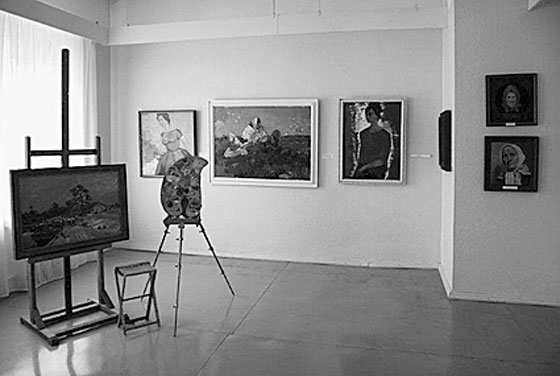|
|
| Alūksne Museum Una Sedleniece, Culture Theorist | |
| Almost 200 years have passed, but the buildings erected by Livonia’s Secret Counsellor and St. Petersburg senator, manor owner Otto Hermann von Vietinghoff(1) and his successors are still the most noteworthy sights in Alūksne for all those interested in history, and also the venues for the more significant events, both spiritual and secular, of the local community. The skillfully selected positioning of the Vietinghoff manor ensemble and the park on the banks of a picturesque lake form the nucleus of the town centre, and influence the rhythm and pattern in time and space of the places where Alūksne residents gather. The former brewery of the estate now houses a community centre, but the New Manor House – a museum. I frequently come to Alūksne, however the inside of the museum is not the place that presents serious competition to other pastimes on offer. Once more confirming the pestilence of malfunctioning visual communication already witnessed during earlier museum expeditions, at the Alūksne Museum, too, we come across two information boards – one at the museum entrance at Pils iela 74, and the other one at the museum premises on the first floor. Both are such a hotchpotch and so poorly laid out that it is not easy to get an immediate picture of what the museum’s programmatic line is. It should also be added that information about what the museum offers on the district council’s website(2) can neither be easily found, nor is encouraging for an individual adult visitor. | |
 The New Manor House - the Alūksne Museum. Photo: Una Sedleniece | |
| Out of eleven ex¬hibitions and expositions currently offered by the Alūksne Museum, one can sense a certain character of longevity in about a half. One can guess, however, that the expositions concerning the Marienburg fortress, the Soviet era sculptures and the open collection are being constantly improved and regularly rearranged. Within the series of historical displays, for a year now the museum has been showing an exhibition arranged by unsophisticated methods but cleverly arranged and entitled Look into the Mirror. This tells the story of local hairdressers in the early 20th century, when Alūksne was granted the status of a town. The exhibition marks a distinctive dividing line that moves Alūksne away from the rural traditions featured in the display A Room of Our Ancestors in one of the adjacent rooms. Another room hosts a surprisingly evocative and harmonious display of devices for playing sound recordings, assembled by a local collector Pēteris Zālītis. The collection of antique gra¬mo¬phones and other, more recent machines not only fits in well with the atmosphere of the manor, but the clear display and rhythm of presentation throw a line for curiosity, stimulate understanding and serve as proof of a serious attitude, both towards the museum pieces and the viewer. On the whole, one gets an impression that this museum is in a process of constant change, seeking the best (and under conditions of an enduring shortage of funds – the cheapest) manner of expression, in order to fulfill the mission they have themselves formulated: to prevent the loss of local identity through the promotion of interest and understanding about the history of Alūksne, the preservation of cultural and historic heritage by highlighting its distinctiveness, starting from the earliest testimonies, carrying out its research and ensuring its accessibility for the wider public(3). As is often the case with museums of local lore, art has not received a great deal of attention; the scope and quality of the collections of art objects is determined by local events, artists and collectors living or working in the area, as well as accidental combinations of events. An active and purposeful development of a collection would require the kind of financial resources which the museum does not possess. In the distant past an extensive collection of art objects that von Vietinghoff had assembled is said to have adorned the house and the adjacent conservatory. Currently, the Alūksne Museum holds a mere estimated 800 works of art, mostly paintings and drawings of the 20th century. First of all, in the cellars I met with some long-forgotten companions of my childhood – sculptures from the Alūksne sculpture garden, thoroughly respectable specimens of Soviet era sculpture that, due to their moral/ideological incongruity, have ceased serving their original purpose and now, in crowded company with other artifacts of Soviet ideology, are being stored in the museum. There was a time when the figures, being stationed in commanding positions in the public space, were an inseparable part of the townspeople’s daily lives. Thus what recently happened to those sculptures is not only an ironic turn of fate, but also something closely related to issues of local identity. The message of the exposition Sculptures and other witnesses to the recent past cannot yet be clearly perceived, still the makers do not cause the viewer to drown in touristic and trite sensationalism, but rather encourage reflection on one’s own relations with the ideology of a recent past. It is easy to imagine that the message will gradually crystallize, as the mu¬seum staff analyse the reactions and opinions of the visitors to this exhibition. | |
 The view from 'The Story of Leo Kokle' exposition. Photo: Una Sedleniece | |
| Another permanent exposition room directly related to art is The Story of Leo Kokle which, unlike the objects of the sculpture garden, has stood above ideological changes and carried out its function since 1979, when the museum received a donation – memorial objects and some 20 works of art of the Alūksne-born artist that had previously been displayed in a memorial room in Rīga. Under the influence of the visit to Alūksne Museum, I read with enthusiasm Ilze Konstante’s monograph about Leo Kokle, and have now noticed posters announcing next season’s performances of Leo. The Last Bohemian at the National Theatre in Riga. It seems that quite a number of people interested in Latvian culture will turn to an investigation of Kokle this year. At present it is difficult to assert that “paintings, the palette, some pieces of clothing created an impression that the artist had gone out just for a second, would return soon, and everything would continue as before (..)”.(4) The Leo Kokle room in Alūksne Museum makes one seriously reflect about what exactly is that authentic quality that, in addition to the works of art themselves, is able to convey an artist’s ideas, emotions, personality. It is difficult to make out whether in the Alūksne museum it is the appliance for measuring moisture content on Kokle’s table, or the room full of an invisible but weird and slightly formal reverence that interferes with conveying the atmosphere. Of course, this does not have any impact on the quality of the paintings. At the end of July this year, museum staff proudly demonstrated the manor house attic had been cleared, which has expanded the tangible and intangible metres squared of the museum’s exhibition rooms. The newly-acquired rooms were opened right away with a show of photographs by artist Klaus Stöber, An Unusual Journey through Vidzeme, created in 2008/2009 under a cooperation agreement between Vidzeme Region and the Bas-Rhin Department in France, and now on show in Vidzeme museums. Some of the photographs also feature Alūksne. It soon becomes evident that this is both a social and an art project. The artist has enthusiastically explored scenes from out-of-the-way places and marginal phenomena, with deep respect transforming the documents of social environment into aesthetic images which do not require any conservative embellishment. It can be seen that the new exhibition space will give the Alūksne Museum courage to undertake art-related experiments and qualitative changes in the contents. The town’s public space does not offer any evidence that the upgrading of culture infrastructure has so far been a priority for concern by the city fathers (unlike as in Saldus, Tukums, Madona and Rēzekne, as the museum expedition has observed). (1) Sk.: Zilgalvis, Jānis. Latvijas pērles: Kultūrvēsturisks ceļvedis pa 40 skaistākajām Latvijas pilīm un muižām. Rīga: AGB, 2000, 28.–33.lpp. (2) Sk. tiešsaitē: www.aluksne.lv/dome/pasv_iest_k_iest_muzejs.htm. (3) Turpat. (4) Konstante, Ilze. Leo Kokle. Rīga: Neputns, 2005, 169. lpp. /Translator into English: Sarmīte Lietuviete/ | |
| go back | |







